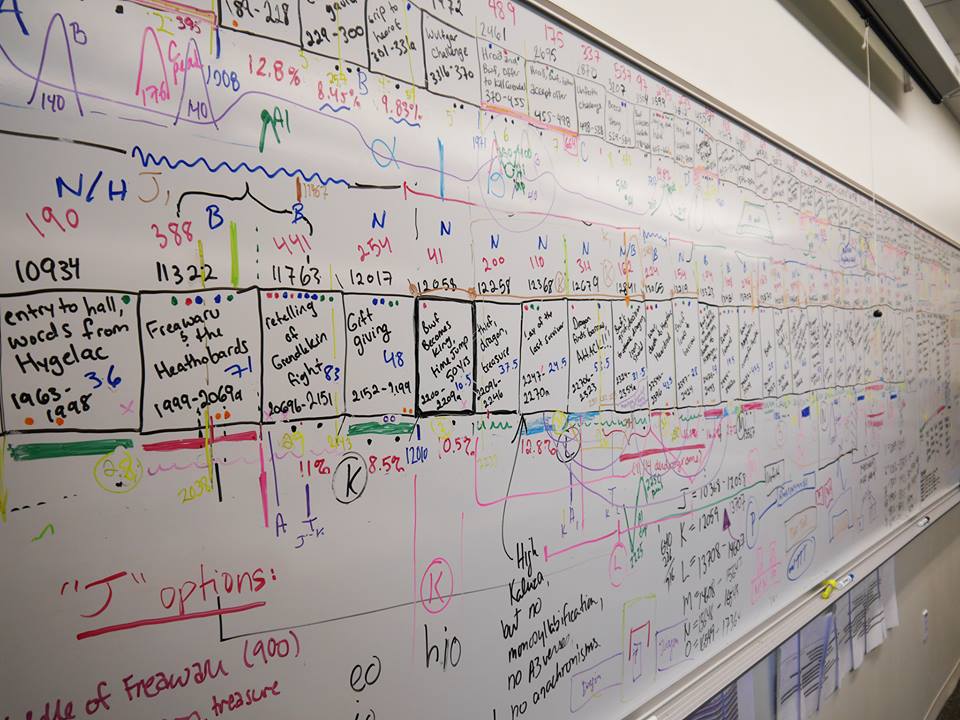Soon Michael Drout and his team publish their long-awaited book on the lexomic analysis of Beowulf. The blurb promises us “The implications of this investigation for the dating, structure, and cultural context of Beowulf will overturn the current scholarly consensus”
Beowulf is one of those texts, which have nearly been thrashed to death by competing scholars out for just about any imaginable bar-fight. Soon, the latest episode is about to unfold, when Michael Drout and his team publishes their long-awaited book on their lexomic analysis of Beowulf.
A lexomic analysis is basically a structural analysis of the bundling of specific words (or rather lexemes, the basic units of meaning, which can be found in any text. The idea behind such analyses is that any author will unwittingly make his or her stamp on a text; or, alternatively, reveal if he or she has compiled the text from other sources. (Basically this is also the technique used to expose students who try to cheat be “reusing texts”.)
For some years now Michael Drout – also known as the blogger responsible for wormtalk and slugspeak – has taken part in running the Lexomics Research Group at Wheaton College. So far, this has yielded a number of exciting results concerning a number of Anglo-Saxon and other texts. However, it is the results of their lexomic study of Beowulf, which has been awaited eagerly by half of academia (consisting of hard-core philologists). The rest, the literary scholars, are probably busy manning the barricades. The reason is that come end of May, the team will publish their book on the results. The blurb tells us that this book, “the most original and ground-breaking work on Beowulf in several decades…uses lexomic” methods that blend computer-assisted statistical analysis with traditional approaches to reveal new and surprising information about the construction and sources of the greatest surviving Old English poem. Techniques of cluster analysis identify patterns of vocabulary distribution that indicate robust similarities and differences among segments of the poem. The correlation of these patterns with knowledge gained from source-study, philological analysis, and neglected previous scholarship sheds new light on the material of which Beowulf was made and the way it was composed. The implications of this investigation for the dating, structure, and cultural context of Beowulf will overturn the current scholarly consensus and significantly improve our understanding of the poem, its nature, and origins”.
It is very apparent that Drout and his people have been able to keep at least some of their conclusions under wraps. Extensive google-search has not satisfied us here at Medieval Histories as to what these implications exactly are. However, rumours have circulated, since Drout & Co has been obliged to give papers and teach, which means that we seem to know that at least a year ago, Drout believed that a fair hypothesis was that Beowulf was the work of a highly talented poet/compiler who found his material in a series of different textual compilations, which he then began to weave together into a united whole; much like Tolkien – due to his lifelong immersion in the text – came to believe the poem had come about.
As to the date: it is perhaps pertinent that Drout together with Emily Bowman and Phoebe Boyd wrote an enlightened defence for the new 21st century quest for an early dating of Beowulf in the recent book edited by Leonard Neidorf on Dating Beowulf (Boydell and Brewer 2014). May we surmise that at least some of the conclusions in the new book will reflect this?
Foremost, the upcoming book about to be published (June, 2016) will hopefully enlighten us about the hard-core linguistic information, which modern scientific and computerised approaches can yield.
SOURCE
Beowulf Unlocked. New Evidence from Lexomic Analysis
By M.D.C. Drout, Y. Kisor, L. Smith, A. Dennett,and N. Piirainen
Palgrave Macmillan 2016
eBook ISBN 978-3-319-30628-5
ISBN 978-3-319-30627-8
SEE MORE:
FEATURED PHOTO:
Beowulf unlocked. By courtesy of Michael Drout
